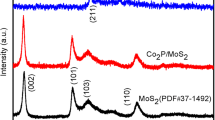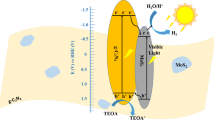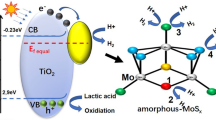Abstract
Utilizing cocatalysts is an effective measure to enhance photocatalytic activities of photocatalysts. Nevertheless, noble-metal cocatalysts such as Pt and Au impose astounding costs on the application of photocatalytic technology. Herein, noble-metal-free MoS2 was used as a cocatalyst to improve the photocatalytic activity of visible-light-responsive TaON for the first time. This work indicates that MoS2/TaON presented higher activity than Pt/TaON while MoS2 costs much less than Pt. The photocatalytic degradation ratio of RhB over Ta1Mo1 (mass ratio of TaON:MoS2 = 1:1) was about 65% after 2 h visible light irradiation, which is about five times higher than that of pure TaON. Furthermore, MoS2/SiO2/TaON ternary photocatalysts were constructed to further improve the photocatalytic performance. When the mass ratio of Ta8Si1 (mass ratio of TaON:SiO2 = 8:1) to MoS2 was 1:1, the degradation ratio of RhB reached 75% after 2 h visible light irradiation. This work provides a facile method to construct high-efficient photocatalysts with the noble-metal-free cocatalyst MoS2, paving the way to realize the application of cheap and environment-friendly photocatalysis.








Similar content being viewed by others
References
Hou Y, Abrams BL, Vesborg PCK et al (2011) Bioinspired molecular co-catalysts bonded to a silicon photocathode for solar hydrogen evolution. Nat Mater 10:434–438
Fujishima A, Honda K (1972) Electrochemical photolysis of water at a semiconductor electrode. Nature 238:37–38
Peng F, Zhou Q, Zhang D et al (2015) Bio-inspired design: Inner-motile multifunctional ZnO/CdS heterostructures magnetically actuated artificial cilia film for photocatalytic hydrogen evolution. Appl Catal B Environ 165:419–427
Zhang D, Wang W, Peng F et al (2014) A bio-inspired inner-motile photocatalyst film: a magnetically actuated artificial cilia photocatalyst. Nanoscale 6:5516–5525
Chen X, Liu L, Huang F (2015) Black titanium dioxide (TiO2) nanomaterials. Chem Soc Rev 44:2019
Hisatomi T, Kubota J, Domen K (2014) Recent advances in semiconductors for photocatalytic and photoelectrochemical water splitting. Chem Soc Rev 43:7520–7535
Ran J, Zhang J, Yu J et al (2014) Earth-abundant cocatalysts for semiconductor-based photocatalytic water splitting. Chem Soc Rev 43:7787–7812
Ullah H (2017) Inter-molecular interaction in polypyrrole/TiO2: a DFT study. J Alloys Compds 692:140–148
Kou J, Gao J, Li Z et al (2015) Construction of visible-light-responsive SrTiO3 with enhanced CO2 adsorption ability: highly efficient photocatalysts for artifical photosynthesis. Catal Lett 145:640–646
Nasir SNFM, Ullah H, Ebadi M et al (2017) New insights into Se/BiVO4 heterostructure for photoelectrochemical water splitting: a combined experimental and DFT study. J Phys Chem C 121:6218–6228
Ullah H, Tahir AA, Mallick TK (2018) Structural and electronic properties of oxygen defective and Se-doped p-type BiVO4(001) thin film for the applications of photocatalysis. Appl Catal B Environ 224:895–903
Safaei J, Ullah H, Mohamed NA (2018) Enhanced photoelectrochemical performance of Z-scheme g-C3N4/BiVO4 photocatalyst. Appl Catal B Environ 234:296–310
Ong W, Tan L, Chai S et al (2014) Self-assembly of nitrogen-doped TiO2 with exposed 001 facets on a graphene scaffold as photo-active hybrid nanostructures for reduction of carbon dioxide to methane. Nano Res 7:1528–1547
Zhang F, Yamakata A, Maeda K et al (2012) Cobalt-modified porous single-crystalline LaTiO2N for highly efficient water oxidation under visible light. J Am Chem Soc 134:8348–8351
Maeda K, Higashi M, Siritanaratkul B et al (2011) SrNbO2N as a water-splitting photoanode with a wide visible-light absorption band. J Am Chem Soc 133:12334–12337
Hara M, Hitoki G, Takata T et al (2003) TaON and Ta3N5 as new visible light driven photocatalysts. Catal Today 78:555–560
Maeda K, Higashi M, Lu D et al (2010) Efficient nonsacrificial water splitting through two-step photoexcitation by visible light using a modified oxynitride as a hydrogen evolution photocatalyst. J Am Chem Soc 132:5858–5868
Moriya Y, Takata T, Domen K (2013) Recent progress in the development of (oxy)nitride photocatalysts for water splitting under visible-light irradiation. Coordin Chem Rev 257:1957–1969
Li S, Hu S, Jiang W et al (2017) Synthesis of n-type TaON microspheres decorated by p-type Ag2O with enhanced visible light photocatalytic activity. Mol Catal 435:135–143
Kou J, Li Z, Yuan Y et al (2009) Visible-light-induced photocatalytic oxidation of polycyclic aromatic hydrocarbons over tantalum oxynitride photocatalysts. Environ Sci Technol 43:2919–2924
Wang Z, Xie K, Zhao L et al (2015) Hierarchical nanostructures of gamma-TaON flowers for enhanced visible light driven photocatalytic activities. Chem Commun 51:2437–2439
Ito S, Thampi KR, Comte P et al (2005) Highly active meso-microporous TaON photocatalyst driven by visible light. Chem Commun 268:268–270
Wang Z, Hou J, Yang C et al (2014) Three-dimensional MoS2-CdS-gamma-TaON hollow composites for enhanced visible-light-driven hydrogen evolution. Chem Commun 50:1731–1734
Zhou W, Yin Z, Du Y et al (2013) Synthesis of few-layer MoS2 nanosheet-coated TiO2 nanobelt heterostructures for enhanced photocatalytic activities. Small 9:140–147
Shen M, Yan Z, Yang L et al (2014) MoS2 nanosheet/TiO2 nanowire hybrid nanostructures for enhanced visible-light photocatalytic activities. Chem Commun 50:15447–15449
Hou Y, Wen Z, Cui S et al (2013) Constructing 2D porous graphitic C3N4 nanosheets/nitrogen-doped graphene/layered MoS2 ternary nanojunction with enhanced photoelectrochemical activity. Adv Mater 25:6291–6297
Zhou G, Xu X, Yu J et al (2014) Vertically aligned MoS2/MoOx heterojunction nanosheets for enhanced visible-light photocatalytic activity and photostability. CrystEngComm 16:9025–9032
Hu KH, Hu XG, Xu YF et al (2010) Synthesis of nano-MoS2/TiO2 composite and its catalytic degradation effect on methyl orange. J Mater Sci 45:2640–2648. https://doi.org/10.1007/s10853-010-4242-9
Lee HS, Min S, Chang Y et al (2012) MoS2 nanosheet phototransistors with thickness-modulated optical energy gap. Nano Lett 12:3695–3700
Stokes P, Khondaker SI (2010) evaluating defects in solution-processed carbon nanotube devices via low-temperature transport spectroscopy. ACS Nano 4:2659–2666
Eda G, Maier SA (2013) Two-dimensional crystals: managing light for optoelectronics. ACS Nano 7:5660–5665
Min Y, He G, Xu Q et al (2014) Dual-functional MoS2 sheet-modified CdS branch-like heterostructures with enhanced photostability and photocatalytic activity. J Mater Chem A 2:2578–2584
Lu D, Wang H, Zhao X et al (2017) Highly efficient visible-light-induced photoactivity of Z-Scheme g-C3N4/Ag/MoS2 ternary photocatalysts for organic pollutant degradation and production of hydrogen. ACS Sustain Chem Eng 5:1436–1445
Liu X, Xing Z, Zhang Y et al (2017) Fabrication of 3D flower-like black N–TiO2–x@MoS2 for unprecedented-high visible-light-driven photocatalytic performance. Appl Catal B-Environ 201:119–127
Zong X, Wu G, Yan H et al (2010) Photocatalytic H2 evolution on MoS2/CdS catalysts under visible light irradiation. J Phys Chem C 114:1963–1968
Liu M, Li F, Sun Z et al (2014) Noble-metal-free photocatalysts MoS2-graphene/CdS mixed nanoparticles/nanorods morphology with high visible light efficiency for H2 evolution. Chem Commun 50:11004–11007
Xiang Q, Yu J, Jaroniec M (2012) Synergetic effect of MoS2 and graphene as cocatalysts for enhanced photocatalytic H2 production activity of TiO2 nanoparticles. J Am Chem Soc 134:6575–6578
Liu C, Wang L, Tang Y et al (2015) Vertical single or few-layer MoS2 nanosheets rooting into TiO2 nanofibers for highly efficient photocatalytic hydrogen evolution. Appl Catal B Environ 164:1–9
Peng W, Wang X, Li X (2014) The synergetic effect of MoS2 and graphene on Ag3PO4 for its ultra-enhanced photocatalytic activity in phenol degradation under visible light. Nanoscale 6:8311–8317
Song Y, Lei Y, Xu H et al (2015) Synthesis of few-layer MoS2 nanosheet-loaded Ag3PO4 for enhanced photocatalytic activity. Dalton Trans 44:3057–3066
Abedi S, Morsali A (2014) Ordered mesoporous metal organic frameworks incorporated with amorphous TiO2 as photocatalyst for selective aerobic oxidation in sunlight irradiation. ACS Catal 4:1398–1403
Ullah H, Tahir AA, Bibi S et al (2018) Electronic properties of β-TaON and its surfaces for solar water splitting. Appl Catal B Environ 229:24–31
Wang P, Shi P, Hong Y et al (2015) Facile deposition of Ag3PO4 on graphene-like MoS2 nanosheets for highly efficient photocatalysis. Mater Res Bull 62:24–29
Li J, Liu X, Pan L et al (2014) MoS2-reduced graphene oxide composites synthesized via a microwave-assisted method for visible-light photocatalytic degradation of methylene blue. RSC Adv 4:9647–9651
Laursen AB, Pedersen T, Malacrida P et al (2013) MoS2-an integrated protective and active layer on n(+)p-Si for solar H2 evolution. Phys Chem Chem Phys 15:20000–20004
Zong X, Na Y, Wen F et al (2009) Visible light driven H2 production in molecular systems employing colloidal MoS2 nanoparticles as catalyst. Chem Commun 30(30):4536–4538
Woodhead K, Pascarelli S, Hector AL et al (2014) High pressure polymorphism of β-TaON. Dalton Trans 43:9647–9654
Zhan YJ, Liu Z, Najmaei S et al (2012) Large-area vapor-phase growth and characterization of MoS2 on SiO2. Small 8(7):966–971
Sun L, Liu X, Zhou H (2015) Design and fabrication of mesoporous heterogeneous basic catalysts. Chem Soc Rev 44:5092–5147
Sun L, Liu X, Li A et al (2014) Template-derived carbon: an unexpected promoter for the creation of strong basicity on mesoporous silica. Chem Commun 50:11192–11195
Wang X, Wang S, Hu W et al (2014) Synthesis and photocatalytic activity of SiO2/g-C3N4 composite photocatalyst. Mater Lett 115:53–56
Ang TP, Chan YM (2011) Comparison of the melon nanocomposites in structural properties and photocatalytic activities. J Phys Chem C 115:15965–15972
Acknowledgements
Financial support from National Natural Science Foundation of China (No. 51872138), Natural Science Foundation of Jiangsu Province (Nos. BK20150919, BK20181380), Jiangsu Province Postdoctoral Fund (No. 1302096C), Key University Science Research Project of Jiangsu Province (No. 15KJB430022), Priority Academic Program Development of the Jiangsu Higher Education Institutions (PAPD), Qing Lan Project, Six Talent Peaks Project in Jiangsu Province (No. XCL-029), Postgraduate Research and Practice Innovation Program of Jiangsu Province (KYCX18_1083) is gratefully acknowledged.
Author information
Authors and Affiliations
Corresponding authors
Electronic supplementary material
Below is the link to the electronic supplementary material.
Rights and permissions
About this article
Cite this article
Chen, Y., Tan, L., Sun, M. et al. Enhancement of photocatalytic performance of TaON by combining it with noble-metal-free MoS2 cocatalysts. J Mater Sci 54, 5321–5330 (2019). https://doi.org/10.1007/s10853-018-03214-9
Received:
Accepted:
Published:
Issue Date:
DOI: https://doi.org/10.1007/s10853-018-03214-9




